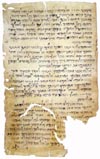One of the Dead Sea Scrolls, 4Q Testimonia
Researchers who probed tiny pieces of a Dead Sea Scroll with protons found that its chemistry matches the chemistry of the water in the area where the ancient document was found – in Qumran, near the Dead Sea. This supports the idea that it was made locally, according to the INFN, Italy’s National Institute for Nuclear Physics.
This particular scroll, one of 900 that were discovered half a century ago in caves near the Dead Sea, is known as the Temple Scroll. Unlike other Dead Sea scrolls that constitute the earliest known biblical texts, dating from about 200 years before the birth of Christ to several decades after it, this one describes the construction and life of a temple and dictates how laws are to be communicated to the people.
The analysis was done at INFN’s National Laboratories of the South using protons from a particle accelerator and a new system, called XPIXE, that was invented there. Details are in the INFN press release.







